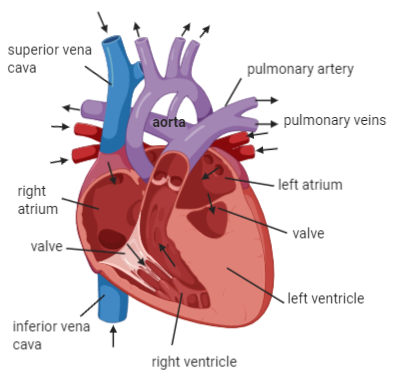
Describe the structure of the heart of a rabbit. Draw a neat, labeled diagram of L.S. of heart.
Answer
570.9k+ views
Hint:
Blood is an essential body fluid in the body of humans and other animals.
It helps in transport of various important nutrients and oxygen to the body cell and carries out the metabolic waste away from the same cell.
It is composed of many blood cells suspended in the plasma.
Heart is the only organ which helps in pumping blood to different parts of the body.
Complete answer:
The heart of the rabbit is four-chambered.
There are two auricles and two ventricles.
The ventricles are larger than the auricles.
The auricles are thin walled compared to the ventricles.
The interauricular septum separates the right and left auricle.
The aperture in the right ventricle is known as sinu-auricular aperture.
The pulmonary vein opens in the left auricle through an oblique aperture.
The two auricles are separated from the ventricles by auriculo-ventricular septum.
The right and left auricle open into the ventricle through auriculo-ventricular aperture.
This aperture is guarded by auriculo ventricular valve.
This valve consists of four flaps.
Chordae tendineae are thread-like chords which are attached to the muscular wall of the ventricle at each end.
Conus arteriosus is the basal, broad and thick-walled portion of the truncus arteriosus.
Ventral aorta is the anterior, thin walled and narrow portion of the truncus arteriosus.
There is a spinal valve in the conus arteriosus and the valve divides the lumen of the conus arteriosus into a left cavum pulmocutaneous and right cavum aorticum.
The blood entering the cavum pulmocataeum enters through pulmocutaneous arches.
The ventral aorta divides into two lateral aortae.
Each lateral aorta is divided into two arches, carotid arch and systemic arch.

Note: Double circulation is found in rabbits.
Double circulation means blood passes twice or two times through the heart in one complete cycle.
This type of circulation is mostly found in amphibians, reptiles, birds and mammals.
Blood is an essential body fluid in the body of humans and other animals.
It helps in transport of various important nutrients and oxygen to the body cell and carries out the metabolic waste away from the same cell.
It is composed of many blood cells suspended in the plasma.
Heart is the only organ which helps in pumping blood to different parts of the body.
Complete answer:
The heart of the rabbit is four-chambered.
There are two auricles and two ventricles.
The ventricles are larger than the auricles.
The auricles are thin walled compared to the ventricles.
The interauricular septum separates the right and left auricle.
The aperture in the right ventricle is known as sinu-auricular aperture.
The pulmonary vein opens in the left auricle through an oblique aperture.
The two auricles are separated from the ventricles by auriculo-ventricular septum.
The right and left auricle open into the ventricle through auriculo-ventricular aperture.
This aperture is guarded by auriculo ventricular valve.
This valve consists of four flaps.
Chordae tendineae are thread-like chords which are attached to the muscular wall of the ventricle at each end.
Conus arteriosus is the basal, broad and thick-walled portion of the truncus arteriosus.
Ventral aorta is the anterior, thin walled and narrow portion of the truncus arteriosus.
There is a spinal valve in the conus arteriosus and the valve divides the lumen of the conus arteriosus into a left cavum pulmocutaneous and right cavum aorticum.
The blood entering the cavum pulmocataeum enters through pulmocutaneous arches.
The ventral aorta divides into two lateral aortae.
Each lateral aorta is divided into two arches, carotid arch and systemic arch.

Note: Double circulation is found in rabbits.
Double circulation means blood passes twice or two times through the heart in one complete cycle.
This type of circulation is mostly found in amphibians, reptiles, birds and mammals.
Recently Updated Pages
Master Class 12 Business Studies: Engaging Questions & Answers for Success

Master Class 12 Economics: Engaging Questions & Answers for Success

Master Class 12 English: Engaging Questions & Answers for Success

Master Class 12 Maths: Engaging Questions & Answers for Success

Master Class 12 Social Science: Engaging Questions & Answers for Success

Master Class 12 Chemistry: Engaging Questions & Answers for Success

Trending doubts
What are the major means of transport Explain each class 12 social science CBSE

Which are the Top 10 Largest Countries of the World?

Draw a labelled sketch of the human eye class 12 physics CBSE

Explain sex determination in humans with line diag class 12 biology CBSE

The pH of the pancreatic juice is A 64 B 86 C 120 D class 12 biology CBSE

Explain sex determination in humans with the help of class 12 biology CBSE




